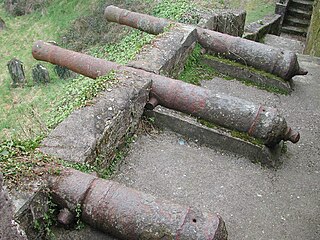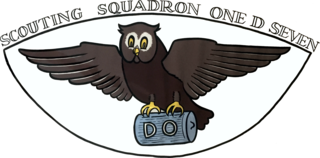
In military organizations, an artillery battery is a unit of artillery, mortars, rocket artillery, multiple rocket launchers, surface to surface missiles, ballistic missiles, cruise missiles, etc., so grouped to facilitate better battlefield communication and command and control, as well as to provide dispersion for its constituent gunnery crews and their systems. The term is also used in a naval context to describe groups of guns on warships.

USS O'Flaherty (DE-340) was a John C. Butler-class destroyer escort built for the United States Navy during World War II. She was named for Ensign Frank Woodrow O'Flaherty, a pilot who posthumously received the Navy Cross for his actions at the Battle of Midway.

The Attacker-class were a class of escort aircraft carriers in service with the British Royal Navy during the Second World War.

No. 15 Squadron was a Royal Australian Air Force (RAAF) light bomber and maritime patrol squadron of World War II. The squadron was formed in January 1944 and initially flew anti-submarine patrols off the east coast of Australia. From September that year elements of the squadron took part in the New Guinea Campaign, and the main body of the squadron moved to New Guinea in March 1945. Its duties in New Guinea included anti-submarine and anti-barge patrols as well as attacking Japanese positions. No. 15 Squadron was demobilised after the end of the war, and was formally disbanded in March 1946.

The 3"/50 caliber gun in United States naval gun terminology indicates the gun fired a projectile 3 inches (76 mm) in diameter, and the barrel was 50 calibers long. Different guns of this caliber were used by the U.S. Navy and U.S. Coast Guard from 1890 through the 1990s on a variety of combatant and transport ship classes.

USS Oberrender (DE-344) was a John C. Butler–class destroyer escort built for the United States Navy during World War II. She was named for Lieutenant Commander Thomas Olin Oberrender Jr., the engineering officer of the light cruiser USS Juneau, who was killed when that ship was torpedoed and sunk during the Naval Battle of Guadalcanal in 1942.

Quonset Point Air National Guard Station is the home base of the Rhode Island Air National Guard 143d Airlift Wing. Naval Air Station Quonset Point was a United States Naval Base in Quonset Point, Rhode Island that was deactivated in 1974. Next to NAS Quonset Point was Camp Endicott at Davisville, home of the Naval Construction Battalions known as the Seabees. Quonset Point also gave its name to the Quonset hut, a standardized temporary structure used by the U.S. military starting in World War II. Former US President Richard M. Nixon went through basic naval officer training at Quonset Point in 1942.

USS Oliver Mitchell (DE-417) was a John C. Butler-class destroyer escort built for the United States Navy during World War II. She was named for 2nd Lieutenant Oliver Mitchell, a pilot who posthumously received the Silver Star for his attack on a Japanese destroyer during the Guadalcanal campaign.
Number 58 Squadron was a squadron of the Royal Air Force.
No. 248 Squadron was a squadron of the Royal Air Force, active immediately after World War I, and again during World War II.

The 1st Search Attack Group was a United States Army Air Forces unit that served during World War II. Its last assignment was with First Air Force. It was based at Langley Field, Virginia throughout its existence, and equipped with Boeing B-17 Flying Fortress, Douglas B-18 Bolo, and Consolidated B-24 Liberator aircraft. It was disbanded on 20 April 1944.

VPB-63 was a Patrol Bombing Squadron of the U.S. Navy. The squadron was established as Patrol Squadron 63 (VP-63) on 19 September 1942, redesignated as Patrol Bombing Squadron 63 (VPB-63) on 1 October 1944 and disestablished on 2 July 1945.
VPB-84 was a Patrol Bombing Squadron of the U.S. Navy. The squadron was established as Patrol Squadron 84 (VP-84) on 1 October 1941, redesignated as Patrol Bombing Squadron 84 (VPB-84) on 1 October 1944 and disestablished on 28 June 1945. The squadron flew the PBY-5A Catalina throughout its operational history.

VPB-103 was a Patrol Bombing Squadron of the U.S. Navy. The squadron was established as Bombing Squadron 103 (VB-103) on 15 March 1943, redesignated as Patrol Bombing Squadron 103 (VPB-103) on 1 October 1944 and disestablished on 31 August 1945.

VP-21 was a Patrol Squadron of the U.S. Navy. The squadron was established as Established as Bombing Squadron 111 (VB-111) on 30 July 1943, redesignated Patrol Bombing Squadron 111 (VPB-111) on 1 October 1944, redesignated Patrol Squadron 111 (VP-111) on 15 May 1946, redesignated Heavy Patrol Squadron (Landplane) 11 (VP-HL-11) on 15 November 1946, redesignated Patrol Squadron 21 (VP-21) on 1 September 1948 and disestablished on 21 November 1969. It was the fifth squadron to be designated VP-21, the first VP-21 was redesignated VP-45 on 1 July 1939, the second VP-21 was redesignated VP-1 on 30 July 1940, the third VP-21 was disestablished on 18 April 1942 and the fourth VP-21 was redesignated VPB-21 on 1 October 1944.

VPB-125 was a Patrol Bombing Squadron of the U.S. Navy. The squadron was established as Patrol Squadron 20 (VP-20) on 1 September 1938, redesignated Patrol Squadron 44 (VP-44) on 1 July 1940, redesignated Patrol Squadron 61 (VP-61) on 6 January 1941, redesignated Patrol Squadron 82 (VP-82) on 1 July 1941, redesignated Bombing Squadron 125 (VB-125) on 1 March 1943, redesignated Patrol Bombing Squadron 125 (VPB-125) on 1 October 1944 and disestablished on 8 June 1945.
VPB-129 was a Patrol Bombing Squadron of the U.S. Navy. The squadron was established as Bombing Squadron 129 (VB-129) on 22 February 1943, redesignated Patrol Bombing Squadron 129 (VPB-129) on 1 October 1944 and disestablished on 4 June 1945.
VPB-149 was a Patrol Bombing Squadron of the U.S. Navy. The squadron was established as Bombing Squadron 149 (VB-149) on 16 September 1943, redesignated Patrol Bombing Squadron Squadron 149 (VPB-149) on 1 October 1944 and disestablished on 6 September 1945.
I-69, later I-169, was a Kaidai-class cruiser submarine of the KD6 sub-class built for the Imperial Japanese Navy during the 1930s. She served in World War II, and took part in operations supporting the attack on Pearl Harbor, the Battle of Midway, the Guadalcanal campaign, the Aleutians campaign, and the invasion of the Gilbert Islands. She sank in a diving accident in April 1944.

Scouting Squadron 1-D7 (VS-1D7) was a United States Navy anti-submarine warfare squadron in World War II. It was stationed at Naval Air Station Banana River, Florida (USA).













